Coronavirus (COVID-19): state of the epidemic - 12 November 2021
This report brings together the different sources of evidence and data about the Covid epidemic to summarise the current situation, why we are at that place, and what is likely to happen next.
State of the Epidemic in Scotland – 12 November 2021
Background
This report summarises the current situation on the Covid-19 epidemic in Scotland. It brings together the different sources of evidence and data about the epidemic in Scotland at this point in time, why we are at that place, and what is likely to happen next. This summarises the data up to and including 11 November 2021 on Covid-19 in Scotland. This updates the previous publication published on 5 November[1]. The information in this document helps the Scottish Government, the health service and the wider public sector respond to the epidemic and put in place what is needed to keep us safe and treat people who have the virus.
This edition of the State of the Epidemic summarises current data on Covid-19 at a national and local level, and how Scotland currently compares to the rest of the UK. It looks at the vaccination program in Scotland and its impact. Information is provided about variants of concern and what impact these may have. Bringing this information together in one place gives the opportunity to better understand the current state of the epidemic in Scotland.
Please note that PCR testing might have been affected by half-term holidays throughout October. Testing and case numbers during the period 28-31 October 2021 may have been affected by a data flow issue at the Glasgow lighthouse laboratory, this was cleared on 31 October. The backlog of NHS Scotland Pillar 1 lab test results that Public Health Scotland were unable to report on 2 November due to an issue affecting data flow on the afternoon of 1 November were included in newly reported figures on 3 November.
Key Points
- The reproduction rate R in Scotland, as of 26 October, is estimated as being between 0.9 and 1.1. This has not changed since last week.
- An average of 2,855 cases were reported per day in the 7 days to 11 November. This is a 2% increase from the daily average of 2,786 recorded on 4 November.
- In the last week 7 day case rates have increased in Scotland, but the trend varies across the country.
- There were 362 weekly cases per 100,000 in the week to 8 November (by specimen date). This is an 11% increase from 325 weekly cases per 100,000 on 1 November. This is lower than the most recent peak (825 weekly cases per 100,000 on 6 September) and lower than the peak in July (425 weekly cases per 100,000 recorded on 3 July).
- Case rates (by specimen date) have increased for those aged 0-19, in particular for those aged 5-11, decreased for those aged 60-79 and 80+, and fluctuated for other age bands in the week to 8 November. As of 11 November, the highest case rates were observed amongst those aged under 20, followed by 40-59, 20-39, 60-79 and 80+.
- As determined through the latest weekly ONS survey, the trend in the percentage of people testing positive for Covid-19 in the private residential population remained level in the most recent week in Scotland (31 October to 6 November 2021).
- Latest modelled estimates suggest that as of 26 October there were between 70 and 117 new daily infections per 100,000 people in Scotland.
- Orkney Islands currently has the highest weekly case rate in Scotland reporting 643 weekly cases per 100,000 in the week to 8 November 2021, followed by Clackmannanshire with 612 weekly cases per 100,000, while Shetland Islands has the lowest case rate at 184 per 100,000.
- The number of people in hospital with confirmed Covid-19 on 11 November decreased by 14% from a week previous (4 November) and in the last few days hospital occupancy appears to have plateaued. The number of people in ICU with confirmed Covid-19 appears to have plateaued.
- Average hospital admissions (3-week rolling average) related to Covid-19 in children have decreased in age group 12-17 and remained stable among 5-11 year-olds, but has increased in all other age groups compared to the previous three-week period.
- There were 140 deaths registered in Scotland where coronavirus was mentioned on the death certificate in the week ending 7 November. This a 4% increase from 135 deaths registered in the week to 31 October.
- Nationwide, wastewater Covid-19 levels have dropped by 7% compared to last week, but is still higher than it was a fortnight ago.
- There continues to be uncertainty over hospital occupancy and intensive care in the next three weeks.
- Over 4.3 million people in Scotland have been given a first vaccine against SARS-CoV-2, over 3.9 million have received a second dose, and almost 1.1 million people have received a booster or dose 3 by 11 November.
- The Delta variant remains the dominant strain in Scotland. Prevalence rates of AY.4.2 (Delta+) have increased in recent weeks in both Scotland and England. Clinical implications of Delta+ are still to be determined.
Method
This report brings together a wide range of publicly available figures from a range of data sources. These include publications by Scottish Government, Public Heath Scotland, National Records of Scotland and Office for National Statistics along with scientific publications and SAGE and UKHSA summaries where appropriate to summarise the state of the epidemic in Scotland in a given week. We also provide information on public attitudes to the virus from weekly YouGov polling surveys.
The national picture
The latest R value for Scotland, as of 26 October (using data to 8 November)[2], was between 0.9 and 1.1 (Figure 1), with a growth rate of between -2% and 1%. Both lower and upper limits of R value have not changed since last week.
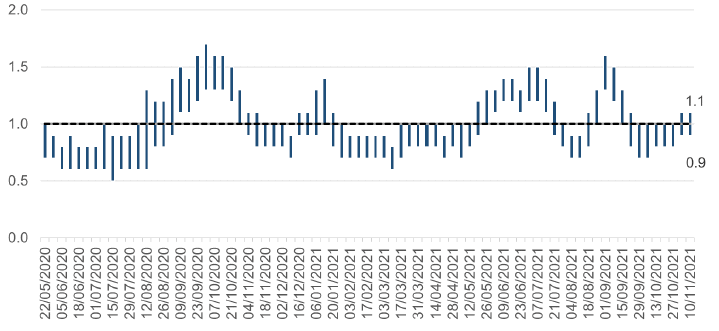
An average of 2,855 cases were reported per day in the 7 days to 11 November. This is a 2% increase from the daily average of 2,786 recorded on 4 November[3]. In the week 30 October to 5 November 2021, there were 407 cases (PCR testing only) per 100,000 amongst the unvaccinated individuals, compared to 277 cases per 100,000 for those that had been vaccinated with two doses[4]. In the last week 7 day case rates have increased in Scotland, but the trend varies across the country. There were 362 weekly cases per 100,000 in the week to 8 November (by specimen date). This is an 11% increase from 325 weekly cases per 100,000 on 1 November)[5]. This is lower than the most recent peak of 825 weekly cases per 100,000 on 6 September and lower than the previous peak of 425 weekly cases recorded on 3 July (see Figure 2).
The number of locations where the levels of SARS-CoV-2 in wastewater are monitored has increased to 110 sites around Scotland. In contrast to Covid-19 case records, virus shedding into wastewater is a biological process. This means that wastewater data is unaffected by factors that impact whether testing is done. Nationwide, wastewater Covid-19 levels have dropped by 7% compared to last week, but is still higher than it was a fortnight ago.
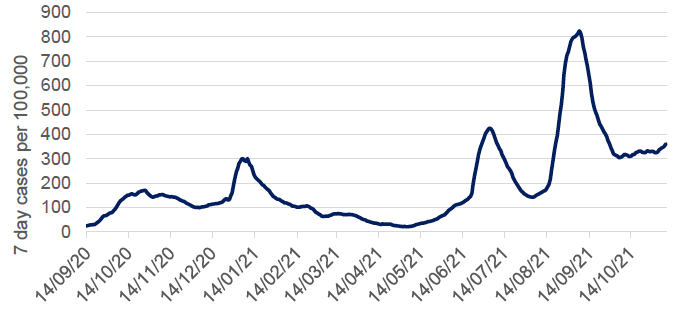
Case rates (by specimen date) have increased for those aged 0-19, in particular for those aged 5-11 (Figure 3 and Figure 7), decreased for those aged 60-79 and 80+, and fluctuated for other age bands in the week to 8 November. In the week 2-8 November, positive cases for under 60s increased by 16% and decreased by 19% for over 60s as compared to the previous week (26 October - 1 November)[6]. As of 11 November, the highest case rates were observed amongst those aged under 20, followed by 40-59, 20-39, 60-79 and 80+ (Figure 3).
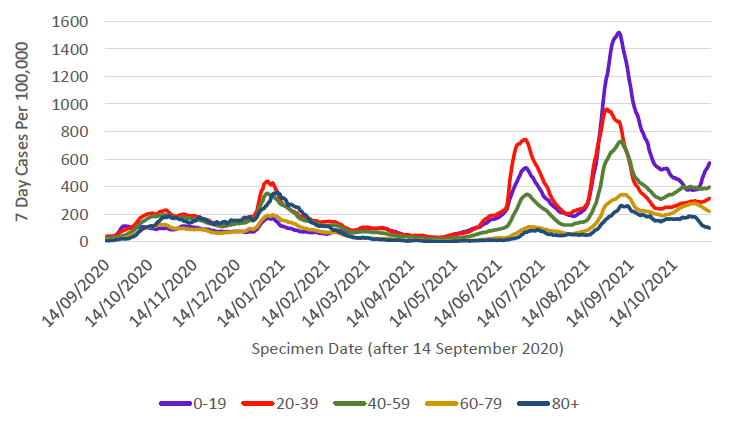
Not everyone who has the virus will be tested, as many people do not realise they have Covid-19, or they have mild symptoms and do not come forward. Latest modelled estimates suggest that, as at 26 October, the incidence of new daily infections in Scotland was between 70 and 117 new infections per 100,000[8]. This equates to between 3,800 and 6,400 people becoming infected each day in Scotland.
The number of people in hospital with confirmed Covid-19 decreased between 4-11 November, but in the latest few days it appears to have plateaued. The number of people in ICU with confirmed Covid-19 appears to have plateaued. The number of people in hospital with confirmed Covid-19 for less than 28 days peaked at 2,053 on 22 January and decreased to a low of 58 on 6 May[9]. This has since increased and as of 11 November there were 768 patients in hospital with Covid-19, which is a 14% decrease from a previous week (893 people in hospital on 4 November) (Figure 4). The latest data from PHS shows 571 admissions to hospital for people with confirmed Covid-19 in the week to 7 November compared to 680 in the week to 31 October[10]. In the 4 weeks to 5 November 23.5% of acute Covid-19 hospital admissions were in unvaccinated individuals[11]. For context, as of 28 October, 90.4% of those aged 12+ have had at least one dose of the vaccine. Overall, individuals in the oldest age groups were most likely to be hospitalised. The age-standardised rate of hospital admissions per 100,000 were higher in unvaccinated individuals compared to vaccinated individuals in the four weeks to 5 November. Unvaccinated individuals were 3.2 times more likely to be in hospital with Covid-19 compared to individuals that had received two doses of vaccine in the period 30 October to 5 November[12].
As the population is increasingly vaccinated, more of the patients in hospital will be fully or partially vaccinated. Therefore, it is important that we can differentiate between patients in hospital because of Covid-19 rather than with Covid-19. Public Health Scotland estimates that as at July 2021, 75% of acute hospital admissions had a primary diagnosis of Covid-19. The trend decreased from 78% in January 2021 to a low of 66% in April 2021, but has since increased[13].
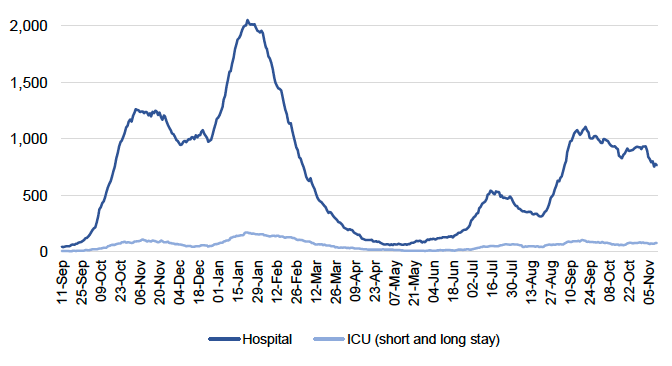
There were 140 deaths registered where Covid-19 was mentioned on the death certificate in the week to 7 November. This is an increase of 5 (+4%) in the number of deaths from the previous week, and 79% lower than the peak in April 2020 (663 deaths). The proportion of deaths in care homes decreased from 60% in April 2020 to 7% in the week to 7 November, with 10 deaths occurring in care homes[15]. In the week ending 7 November, deaths involving coronavirus have increased in those aged 45-64 (from 14 to 23 deaths) and 65-74 (from 29-43 deaths) compared to week ending 17 October. Deaths decreased in those aged 15-44 (from 4 to 2 deaths), 75-84 (from 48-37 deaths), and those aged 85+ (from 46 to 35 deaths). Deaths remained at 0 in those aged under 15 in the same period[16](Figure 5). From 29 December 2020 to 29 October 2021, 69.9% of Covid-19 deaths were in unvaccinated individuals[17]. Amongst those individuals who have been vaccinated with two doses of Covid-19 vaccine, 79.1% of the confirmed Covid-19 deaths occurred in the 70+ age group[18].
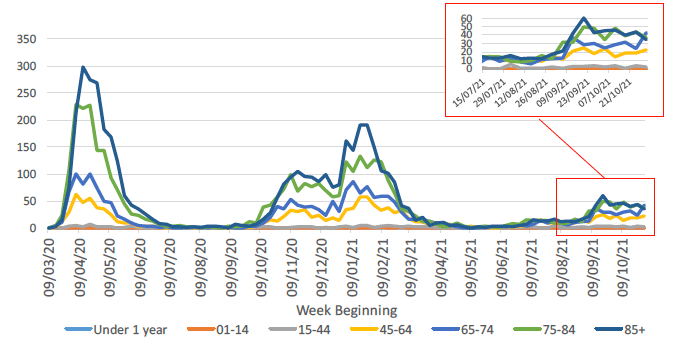
How Scotland compares with the rest of the UK
The ONS Covid-19 Infection Survey estimates that in the week 31 October to 6 November 2021 the estimated percentage of the population living in private residential households testing positive for Covid-19 in Scotland was 1.18% (95% credible interval: 0.95% to 1.42%). The percentage of people testing positive for Covid-19 in the private residential population remained level in the most recent week. Estimates for the week 31 October to 6 November in the other UK nations are as follows: 1.70% (95% credible interval: 1.61% to 1.79%) for England, 2.13% (95% credible interval: 1.73% to 2.57%) for Wales and 1.35% (95% credible interval: 0.98% to 1.77%) for Northern Ireland. This equates to around 1 in 85 people in Scotland, 1 in 60 in England, 1 in 45 in Wales and 1 in 75 in Northern Ireland[19].
The ONS Covid-19 Infection Survey estimated that in the week beginning 18 October 2021, 92.5% (95% CI: 91.0% to 93.7%) of the adult population living in private residential households in Scotland would have tested positive for antibodies against SARS-CoV-2, as a result of having the infection in the past or being vaccinated. This compares to 93.1% in England (95% CI: 91.9% to 94.1%), 91.7% in Wales (95% CI: 90.1% to 93.1%) and 90.9% in Northern Ireland (95% CI: 86.7% to 93.2%)[20].
An estimated 1.9% of the population living in private residential households in the UK were experiencing self-reported long Covid symptoms (symptoms persisting for more than four weeks after the first suspected coronavirus (Covid-19) infection that were not explained by something else) in the 4 weeks ending 2 October 2021. In Scotland, 92,000 people (1.75% of the respective population) living in private households self-reported long Covid symptoms for this period. This compares to 1.90% in England, 1.56% in Wales and 1.43% in Northern Ireland[21].
Average daily deaths in Scotland (3 per 1 million population) in the week to 11 November were similar to Wales and Northern Ireland (3 per 1 million each), and slightly above England (2 per 1 million)[22]. Average daily cases in Scotland (522 per 1 million) in the week to 11 November were below Wales (674 per 1 million) and Northern Ireland (669 per 1 million), and above England (501 per 1 million)[23].
Situation by local authority within Scotland
The trend in case rates varies across the country. Case rates have decreased in Argyll and Bute, West Lothian, Aberdeenshire, Dundee City, Midlothian, and City of Edinburgh over the last week, have remained level in Shetland Islands, and have increased in all other local authorities. Orkney Islands currently has the highest weekly case rate in Scotland reporting 643 weekly cases per 100,000 in the week to 8 November, followed by Clackmannanshire with 612 weekly cases per 100,000, East Ayrshire with 542 weekly cases per 100,000, Na h-Eileanan Siar with 525 weekly cases per 100,000, Angus with 513 weekly cases per 100,000, and Perth and Kinross with 488 weekly cases per 100,000 population. All local authorities reported over 200 weekly cases per 100,000 population in the last week, except for Shetland (Table 1). There are still very high levels (150+ weekly cases per 100,000) of case rates across Scotland (Figure 6). Shetland has the lowest case rate in Scotland, reporting 184 weekly cases per 100,000 in the week to 8 November[24].
| Local authority | Total new cases in the week, per 100,000 population | Change since previous week |
|---|---|---|
| Orkney Islands | 643 | +161 |
| Clackmannanshire | 612 | +25 |
| East Ayrshire | 542 | +71 |
| Na h-Eileanan Siar | 525 | +42 |
| Angus | 513 | +130 |
| Perth and Kinross | 488 | +247 |
| Dumfries and Galloway | 487 | +128 |
| Inverclyde | 436 | +143 |
| Stirling | 429 | +62 |
| Highland | 429 | +107 |
| Falkirk | 425 | +79 |
| Fife | 416 | +66 |
| Moray | 415 | +104 |
| Scottish Borders | 413 | +29 |
| Argyll and Bute | 405 | -11 |
| North Lanarkshire | 397 | +28 |
| South Ayrshire | 389 | +103 |
| West Lothian | 378 | -58 |
| South Lanarkshire | 377 | +26 |
| East Dunbartonshire | 370 | +42 |
| North Ayrshire | 362 | +23 |
| Aberdeen City | 355 | +24 |
| East Renfrewshire | 342 | +91 |
| East Lothian | 333 | +55 |
| West Dunbartonshire | 325 | +23 |
| Aberdeenshire | 321 | -111 |
| Dundee City | 314 | -34 |
| Midlothian | 306 | -13 |
| Renfrewshire | 283 | +30 |
| City of Edinburgh | 236 | -6 |
| Glasgow City | 225 | +9 |
| Shetland Islands | 184 | 0 |
| Scotland | 362 | +36 |
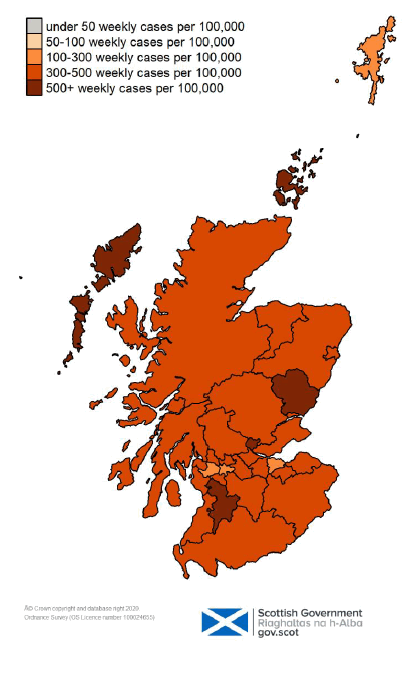
The most recent modelling predicts, based on data up to 8 November, that for the week commencing 21 November 2021, there are 30 local authorities (Shetland and Orkney Islands being exceptions) which are expected to exceed 50 cases per 100,000 population with at least 75% probability. 27 local authorities (Edinburgh, Glasgow, Na h-Eileanan Siar, Orkney and Shetland Islands being the exceptions) are also expected to exceed 100 cases per 100,000 with at least 75% probability. There are no local authorities expected to exceed 300 cases per 100,000 population with at least 75% probability[25].
Children and Education
Schools resumed in Scotland by the week ending 20 August and universities resumed by end of September. Throughout October schools were on half-term holidays, and testing rates in children were lower during this period. The majority of children and young people have returned to full time education.
The total number of Covid-19 cases in young people aged under 22 has increased by 43% over the last week (6,556 cases recorded in the week to 7 November compared to 4,594 cases in the week ending 31 October). The number of cases has increased in all age groups. The percentage of cases made up of children under 12 was 64.8% (4,248 cases) in the week to 7 November, a slight increase from the previous week (60.4%)[26].
7 day case rates per 100,000 have increased in all age groups in the week ending 7 November (Figure 7). However, case rates have increased more sharply in the 5-11 and 12-15 age groups.
The rate of testing increased or remained level amongst all age groups, apart from 20-21 where it decreased in the week ending 7 November. Test positivity rates have decreased in age groups 0-1 and 2-4, however increased or plateaued in other age groups in the same period.
Average hospital admissions (3-week rolling average) related to Covid-19 in children have decreased in age group 12-17 and remained stable among 5-11 year-olds, but has increased in all other age groups compared to the previous three-week period.
Vaccine uptake in 17-21 year olds as at 25 October was 80.1% for the first dose and 62.0% for the second dose[27]. Please note that under half of Scottish students are in this age category and only Scottish students (i.e. registered with a GP in Scotland) are included in the figures. Covid-19 infection survey estimated that up to the week beginning 18 October 2021, the percentage of 16-24 year olds in the community population in Scotland testing positive for antibodies increased to 96.0%[28].
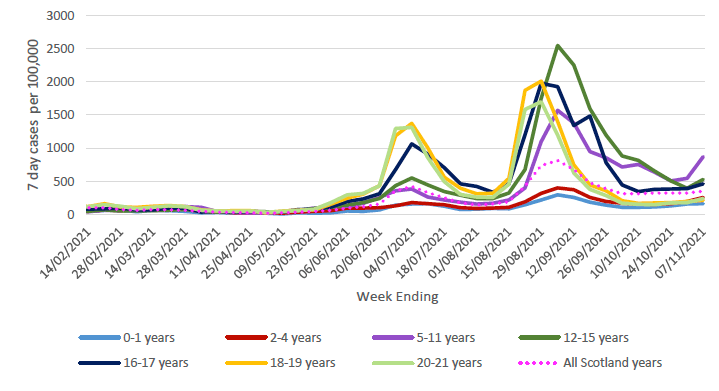
Looking ahead
Changes in patterns of mixing and adherence to restrictions will impact on future case numbers. The Scottish Contact Survey measures times and settings that people mix where they could potentially spread Covid-19.
Average contacts have increased by 8% in the last two weeks (comparing surveys pertaining to 14 October - 20 October and 28 October - 3 November) with a current level of 5 daily contacts.
Mean contacts within the work setting have increased by 44% in the last two weeks. Contacts within the home and other setting (contacts outside home, school and work) have remained at a similar level over the same period.
Those aged between 50-59 reported the biggest increase in overall contacts, increasing by approximately 40% in the last week. This increase is largely driven by a rise in contacts within the other setting.
The biggest changes in the proportion of participants visiting different locations is seen in those attending an event outside and those visiting a pub or restaurant. Visits to an outdoor event have decreased from approximately 72% to 68% with individuals attending an pub or restaurant decreasing from 52% to 48% in the last two weeks.
Self-reported compliance with the current regulations and guidance has decreased since January but remains at a high level. On 2-3 November, 67% of people reported 'complete' or 'almost complete' compliance[29].
There continues to be uncertainty over hospital occupancy and intensive care in the next three weeks (Figure 8)[30].
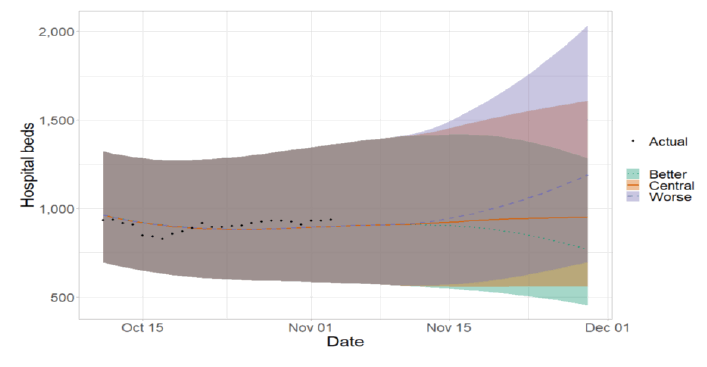
Vaccinations are continuing and 90.4% of the 12+ population in Scotland has now been vaccinated with the first dose[32]. The first vaccines were administered on Tuesday 8 December and 4,326,392 people had received their first dose by 11 November 2021[33].
By age group, almost 100% of individuals aged 55+, 97% of those aged 50-54, 92% of those aged 40-49, 85% of those aged 30-39, 78% of those aged 18-29, 76% of those aged 16-17, and 56% of those aged 12-15 have received their first vaccination (Figure 9).
Almost 100% of individuals aged 60+, 97% of those aged 55-59, 94% of those aged 50-54, 88% of those aged 40-49, 77% of those aged 30-39, 68% of those aged 18-29, 18% of those aged 16-17, and 1% of those aged 12-15 have received their second dose.
77% of individuals aged 80+, 82% of those aged 75-79, 78% of those aged 70-74, 49% of those aged 65-69, 27% of those aged 60-64, 14% of those aged 55-59, 12% of those aged 50-54, 9% of those aged 40-49, 6% of those aged 30-39, 4% of those aged 18-29, 0% of those aged 16-17, and 0% of those aged 12-15 have received their dose 3 or booster vaccination.
Overall, 3,921,971 people (82% of those aged 12 and over) had received their second dose and 1,084,891 people have received their dose 3 or booster vaccine by 11 November[34]. There remains a low level of deaths amongst the vaccinated individuals (Figure 5).
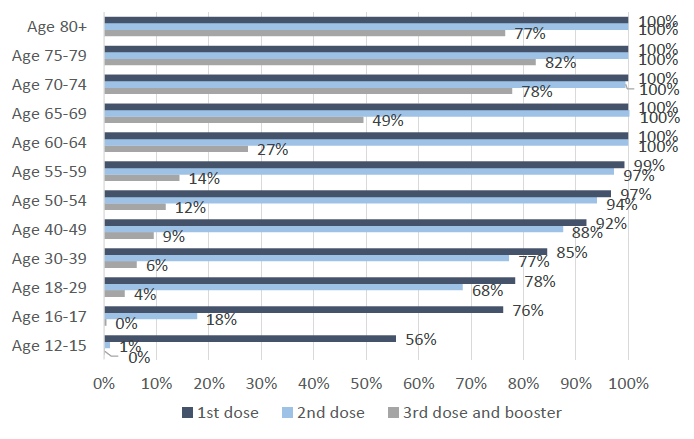
The proportion of people surveyed who said they have been vaccinated for Covid-19 is high. 91% of all respondents have already received at least their first vaccine dose. Of those not vaccinated (and small base must be noted), 6% report they are likely to be vaccinated when a vaccine becomes available to them[35].
How the virus is changing
The variant of concern Delta, also referred to as VOC-21APR-02 (first identified in India) is more transmissible than Alpha variant [36] [37] [38]. It quickly replaced Alpha (VOC-20DEC-01), first identified in the UK, as the dominant strain in Scotland, and 102,029 cases have now been identified as Delta to 10 November 2021. A sublineage of Delta, AY.4.2, has been classified as VUI-21OCT-01, and 4,301 cases have now been identified in Scotland.
To date there are five 'variants of concern' (VOCs) and twelve 'variants under investigation' (VUIs)[39]. There is a concern that some of these new variants may partially escape immunity, from both natural infection and from vaccines currently being deployed and we are monitoring the evidence on this[40] [41] [42]. Up to 10 November there have been 62 genomically confirmed cases of the variant Beta/VOC-20DEC-02 (first detected in South Africa), and 23 cases of Gamma in Scotland. Genomically confirmed cases of other VOCs and VUIs remain low, there have been no new cases of other VOCs or VUIs in the last week (Figure 10). There remains uncertainty regarding the impact of the Delta variant on severity of illness, treatment or reinfections. As more data is analysed we shall become more certain of the impact of Delta on infections, hospitalisations and disease severity and long term vaccine protection effects.
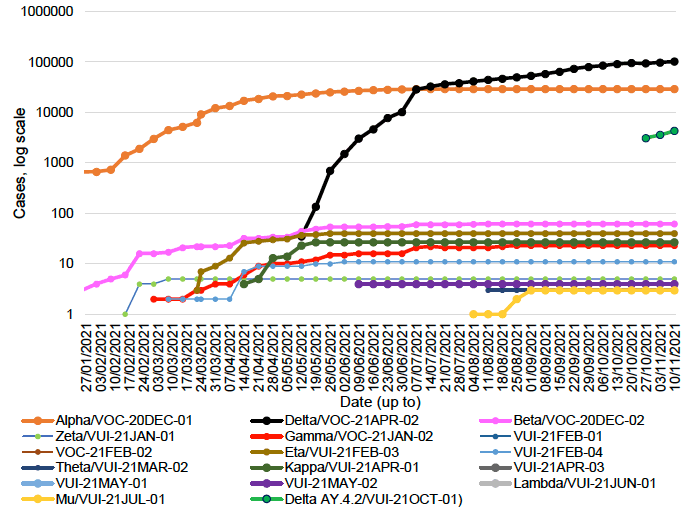
The effectiveness of vaccines
A large study from the University of Oxford and Office of National Statistics shows that with Delta, Pfizer-BioNTech and Oxford-AstraZeneca vaccines still offer good protection against new infections, but effectiveness is reduced compared with Alpha[44]. Public Health England analysis shows that vaccines are highly effective against hospitalisation and death from Delta variant with vaccine effectiveness of over 90% after two doses of vaccine.[45]. EAVE II data from Scotland also shows that both the Oxford–AstraZeneca and Pfizer–BioNTech Covid-19 vaccines are effective in reducing the risk of SARS-CoV-2 infection and Covid-19 hospitalisation in people with the Delta variant, but effectiveness against infection appeared to be diminished when compared to those with Alpha[46]. The latest data released from the EAVE II study revealed that vaccination is over 90% effective at preventing deaths from the Delta variant of Covid-19 (Pfizer-BioNTech 90% effective, Oxford-AstraZeneca 91%)[47]. The vaccine effectiveness expert committee recently published their updated consensus view on the effectiveness of different vaccines on infections, symptomatic disease, and severe disease as well as some initial evidence on vaccine waning effects[48]. The protective effects of vaccines wanes over time, and recently the Joint Committee on Vaccination and Immunisation (JCVI) gave advice on a booster programme to re-vaccinate adults against Covid in the UK[49].
Next steps
The Scottish Government continues to work closely with Public Health Scotland and modelling groups to monitor what happens following the high number of cases in Scotland this week and how this effects the course of the epidemic.
Each week this report will provide an overview of the current Covid-19 situation in Scotland. This will include real time data on case rates, hospitalisations and deaths and how Scotland's figures compare to those from the rest of the UK.
Modelling can tell us where the epidemic is likely to be heading. Local data and data by age group can highlight where problems arise, which can help in addressing some of these issues. In the coming weeks the roll out of the vaccine will continue to be monitored along with the impact of this on case rates and deaths among different age cohorts. Investigations are ongoing by NERVTAG, SPI-M, SAGE, UKHSA, Public Health England and Public Health Scotland regarding the impact of new variants and of vaccination; this will be reflected here as work is undertaken.
Contact
There is a problem
Thanks for your feedback